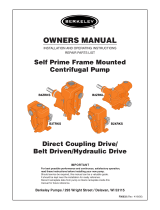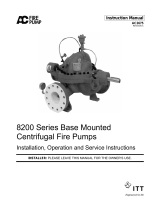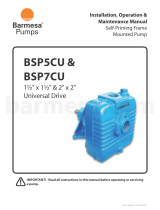Berkeley Self Prime Frame Mounted Centrifugal Pump Owner's manual
- Type
- Owner's manual
This manual is also suitable for
Berkeley Self Prime Frame Mounted Centrifugal Pump is a versatile and powerful device designed to meet a wide range of pumping needs. Its self-priming capability allows it to draw water from depths of up to 8 feet, making it ideal for use in applications where the water source is not located at ground level. The pump's centrifugal design provides high flow rates and pressures, making it suitable for a variety of tasks, including irrigation, water transfer, and drainage.
Berkeley Self Prime Frame Mounted Centrifugal Pump is a versatile and powerful device designed to meet a wide range of pumping needs. Its self-priming capability allows it to draw water from depths of up to 8 feet, making it ideal for use in applications where the water source is not located at ground level. The pump's centrifugal design provides high flow rates and pressures, making it suitable for a variety of tasks, including irrigation, water transfer, and drainage.




















-
 1
1
-
 2
2
-
 3
3
-
 4
4
-
 5
5
-
 6
6
-
 7
7
-
 8
8
-
 9
9
-
 10
10
-
 11
11
-
 12
12
-
 13
13
-
 14
14
-
 15
15
-
 16
16
-
 17
17
-
 18
18
-
 19
19
-
 20
20
-
 21
21
-
 22
22
-
 23
23
-
 24
24
Berkeley Self Prime Frame Mounted Centrifugal Pump Owner's manual
- Type
- Owner's manual
- This manual is also suitable for
Berkeley Self Prime Frame Mounted Centrifugal Pump is a versatile and powerful device designed to meet a wide range of pumping needs. Its self-priming capability allows it to draw water from depths of up to 8 feet, making it ideal for use in applications where the water source is not located at ground level. The pump's centrifugal design provides high flow rates and pressures, making it suitable for a variety of tasks, including irrigation, water transfer, and drainage.
Ask a question and I''ll find the answer in the document
Finding information in a document is now easier with AI
Related papers
-
Berkeley S.A.E. Engine-Mount Centrifugal Pump Owner's manual
-
Berkeley CARE Owner's manual
-
Berkeley B2X, B3T, B4T, B4Z Close Coupled Motor Drive Self Priming Centrifugal Pump Owner's manual
-
Berkeley Type C Centrifugal Owner's manual
-
Pentair Close Coupled Motor Driven Centrifugal Pump Owner's manual
-
Pentair Berkeley B2X Owner's manual
-
Berkeley Vertical Multi-Stage Pumps Motor Kit Adapter Operating instructions
-
Pentair Berkeley LTM-5 Owner's manual
-
Berkeley Centrifugal Care Owner's manual
-
Berkeley SAE & Frame Mount Shaft Replacement Kit Installation guide
Other documents
-
 Berkley B4ZRKS User manual
Berkley B4ZRKS User manual
-
Laufen 9506781 Installation guide
-
Generac 6918 User guide
-
Poolmaster 27402 Operating instructions
-
AMT 3941-96 Installation guide
-
AMT 4260-95 Installation guide
-
 A-C Fire Pump 8200 Series User manual
A-C Fire Pump 8200 Series User manual
-
Hydra-Cell G-04 User manual
-
 Barmesa BSP5CU Installation guide
Barmesa BSP5CU Installation guide
-
Franklin Electric BT4 Series Owner's manual


























